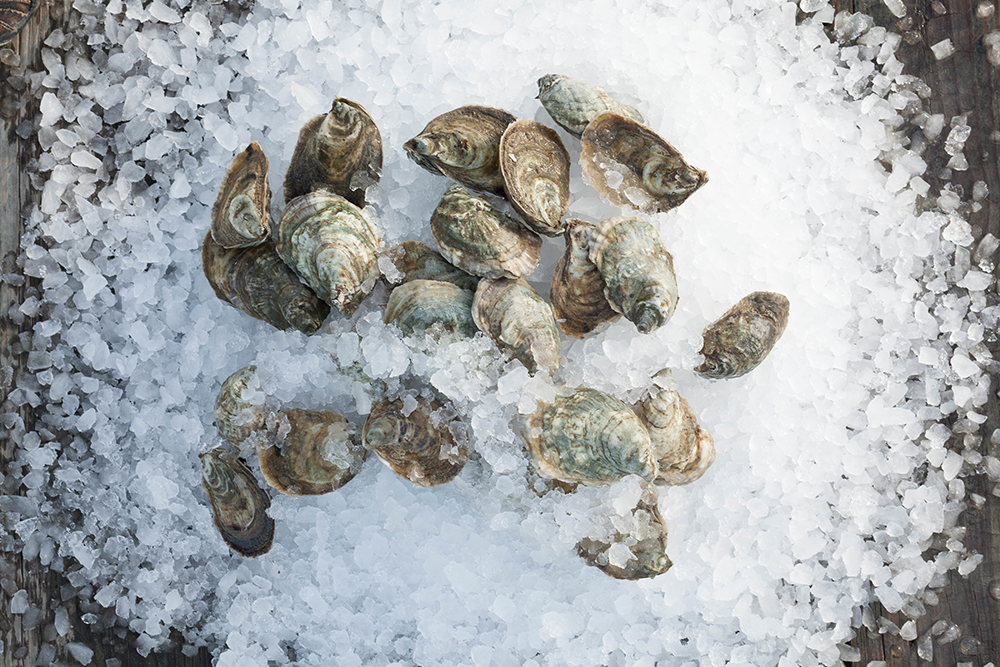Eat
 Photos courtesy of Rappahannock Oyster Company.
Photos courtesy of Rappahannock Oyster Company.
Shucking Delicious: How to Host an Oyster Roast at Home
June 5, 2020 @ 10:00am
Cope with the meat shortage. Boost your immune system. Reduce your carbon footprint. Support small local businesses. Can you name one thing you can do right now to accomplish all four of these admirable goals? I can. And it’s shucking delicious.
Oyster farming in the Chesapeake Bay watershed is a growing industry that creates jobs and plays a critical role in improving local water quality.
“A single healthy adult oyster can filter up to 50 gallons a day,” says Audrey Swanenberg, Chesapeake Oyster Alliance Manager with the Chesapeake Bay Foundation (CBF). “They’re also incredibly important in terms of creating habitat for different types of fin fish, blue crabs.”
The majority of these oysters are going to restaurants. When restaurants closed and pivoted to takeout due to Covid-19, oyster businesses saw their sales drop to zero and were left sitting on thousands of ready-to-eat oysters without a market.
Swanenberg says this poses a number of challenges. Logistically, oysters left in the water for too long will grow past the ideal half shell size (making them less marketable) and can get stuck in cages. Financially, a lack of income prevents farmers from investing in oyster seed to start the next generation of oysters. Plus, if they can’t sell their inventory, there’s nowhere to put baby oysters, even if they do buy them.
“There’s potential that there will be ramifications in years to come,” Swanenberg says.
That’s where we come in. Many oyster farmers are turning directly to consumers to keep their businesses afloat.
“They’ve had to pivot and come up with really creative delivery and shipping options,” Swanenberg says. “I really love this as an opportunity for people to begin to eat oysters at home again.”
Now is your chance to be a hero and have a phenomenal meal: Host an oyster roast. You may not be able to gather a crowd, but you can still have a boatload of fun with a couple of close companions and a whole lot of oysters.
Plus, it’s a sustainable and nutritious choice: “Oysters are the most climate beneficial meat that you can eat. They’re a lot less intensive than say, beef, or anything like that,” Swanenberg says. “They have a super high level of zinc… It’s a really high protein, low fat meat.”
Hosting a roast is simpler than you think, and I’ve consulted bivalve buff Rob Rubba, of the forthcoming sustainability-focused restaurant Oyster Oyster, to break it down for you. Here’s everything you need to know to throw a shellfish shindig.
SOURCING
There’s never been a better opportunity to buy fresh oysters directly from the source, which is always Rubba’s preference.
“That’s the option that people have right now. An average consumer can get directly from an oyster farm,” he says.
Many oyster farmers are offering pickup, delivery and shipping options. Rappahannock Oyster Company in Virginia sells its oysters via their website and ships them to your door. Or, get them through ProFish (pickup and delivery) or Number 1 Sons (delivery).
You can also pick up oysters at The Salt Line or other various locations around the DMV from Sapidus Farms. Visit www.cbf.org and search “oyster businesses” for a more comprehensive list of Virginia and Maryland oyster farms.
Of course, if you’re planning to shuck raw oysters at home, you’ll need the proper equipment, namely a shucking knife, a thick kitchen towel and, for added protection, a shucking glove made of cut-resistant material like rubber or chain mail.
“I think they give people a lot of confidence, security,” Rubba says. “It’s like armor, literally.”
Rubba is partnering with local oyster farms to offer an Oyster Oyster Home Shuck Kit complete with a dozen oysters, ramp mignonette, a shucking knife, a kitchen towel and an instructional shucking printout. It’s available for pickup via Rubba’s pop-up, Scrappy’s Bagels, at Estadio. Rappahannock, Number 1 Sons, Sapidus Farms and The Salt Line also offer kits and shucking knives.
STORING
If you’re buying oysters in the shell, they’re alive, and they’re good as long as they are kept alive. Rappahannock’s FAQs say a week is a safe bet, but that they could live for up to a month if stored properly. A tightly closed shell is good, while an open shell is not. When you open the shell, there should be a briny liquid inside, known as liquor. If you find one that is dry when opened, toss it.
Live oysters should be kept cold in the fridge or on ice (but not in standing water). To extend their life, store them cup-side down. Rappahannock says this takes the stress off the muscle that holds the shell together.
Before storing and eating your oysters, you’ll want to clean off mud or debris by spraying them with a hose or running them under cold water in the sink. This is to prevent any unwanted particles from getting pushed into the shell as you shuck – especially for beginner shuckers.
“It’s just cleaning the exterior,” Rubba says. “It’s not something like a clam where you need to worry about purging sand out of it.”
Then, pop them in the fridge. The storage method that worked best for me is as follows: Clear out the crisper drawer. Line it with a brown paper bag. Place the cleaned oysters cup-side down on the paper. Dampen a thin kitchen towel and drape it over the oysters. (It should just be damp, not dripping.)
SHUCKING
Now for the most intimidating part. I learned to shuck a few years ago, and I can say that while it’s gotten easier for me, it’s much harder than it looks.
The part that’s easy – getting the oyster open. The part that’s much harder – getting the oyster open while leaving the meat intact without getting shell inside. After disfiguring my first oyster, my respect for professional shuckers increased 1,000-fold.
The good news? We’re not being held to professional standards.
“If you happen to stab it and it’s a little mangled or whatever, it’s going to taste the same,” Rubba assures me. “It doesn’t change the flavor.”
So go ahead. Shuck it.
The easiest method for a beginner is to go in through the hinge (the point). Rubba and The Salt Line also have how-to videos available online. Fold up a kitchen towel and place the oyster on it, cup-side down, with the pointed end facing your dominant hand. Fold the towel over the curved side. Place your (gloved) non-dominant hand on the towel to hold the oyster in place and then use your dominant hand to insert the tip of the shucking knife into the crevice in the hinge. Push and wiggle using gentle pressure until the knife is stuck in the oyster – you could let go of the knife handle and it would stay suspended in place. Then, like turning a key, twist or rotate the knife until the shell halves separate slightly.
“It’s a combination of pushing down and twisting at the same time,” Rubba says. “You’re trying to just pop and twist in one motion; not a lot of force is needed.”
Once the oyster has cracked open, continue to pry the shells apart around the edges. Then, wipe your knife off on the towel and slide it along the inside of the flat top shell, keeping the blade as level and as close to the top shell as possible. This will slice the adductor muscle, causing the oyster to release the shell, and you can then pull the top shell off easily. Wipe your knife again and scoop the blade under the oyster to sever it from the bottom shell.
If all of this just seems too difficult or scary, there’s another option that doesn’t require a shucking knife. Cooking the oysters slightly will coax the shell open, and all you have to do is help it along.
Grilled Oyster Ssam
Serves 4-6
2 cups high-quality short grain rice
2 heads butterhead lettuce (such as Bibb)
Ssamjang sauce (recipe follows)
Ginger-scallion sauce (recipe follows)
Sweet pickled daikon radish or other vegetables (homemade or store-bought)
50 oysters, cleaned
Prepare ssamjang and ginger scallion sauces. Cover and refrigerate until ready to serve.
Separate the leaves of lettuce and wash thoroughly.
Let dry in a colander. Arrange on a platter.
Rinse and cook the short grain rice according to directions on the package or your rice cooker. Keep warm.
Grill oysters according to the instructions in the “COOKING” section.
Serve the lettuce, rice, sauces, pickled vegetables and grilled oysters (in the shell). Guests can pry open the oysters themselves (according to the directions in the “COOKING” section) and assemble the wraps with a leaf of lettuce, a few tablespoons of rice, a drizzle of one of the sauces, some pickled vegetables and one to two oysters.
Sauces
Soy-Mirin
For raw oysters on the half shell
3 tablespoons soy sauce
3 tablespoons mirin (sweet cooking rice wine)
3 tablespoons rice vinegar
3 to 4 small shallots, minced
Combine all ingredients in a bowl. Serve in a small ramekin alongside shucked oysters on the half shell over a platter of ice.
Ssamjang
1/4 cup doenjang (soybean paste)
2 teaspoons gochujang (Korean red chili paste)
1 teaspoon honey
2 teaspoons toasted sesame oil
2 tablespoons sherry vinegar
2 tablespoons avocado oil
1 garlic clove, minced
1 scallion, thinly slices
1 teaspoon sesame seeds, toasted
Combine all ingredients in a bowl and adjust seasonings to taste.
Ginger Scallion
2 tablespoons soy sauce
2 tablespoons sherry vinegar
1/4 cup avocado oil
2 tablespoons toasted sesame oil
3 tablespoons grated fresh ginger
3 scallions, thinly sliced
Combine all ingredients in a bowl and adjust seasonings to taste.
COOKING
Oysters are delicious raw on the half shell, but they are also great when gently cooked. The traditional method for a Southern oyster roast involves a fire, a piece of sheet metal and a burlap sack, but Rubba says there are plenty of simpler methods – like steaming, oven-roasting and grilling – that work just as well.
Cook time will vary based on the size of the oyster, but you’ll know when they’re ready because they will pop open slightly (about 1/16th of an inch) and release a little steam (and maybe a hissing sound). In most cases, the pop and hiss will occur after two to five minutes.
“You want to keep your eye on it,” Rubba says. “To get that sweet little perfect moment when it’s just popped and it’s cooked, but it’s still really fresh.”
Steaming: Steam oysters in a bamboo or metal steamer basket until they pop open slightly (not nearly as much as a mussel or clam would open when steamed).
Oven-Roasting: Preheat your oven to 425 degrees Fahrenheit. Arrange oysters on a roasting pan with a flat rack or a sheet pan with tinfoil crumpled to form pockets.
You want to make sure the oysters are sitting up and level so the liquor won’t spill out when they pop open. Add a bit of water under the oysters so there’s moisture in the oven when cooking. Cook until they pop open slightly. Using tongs, transfer the opened oysters to a platter, cup-side down, being careful not to lose any of the liquor.
Grilling: Preheat your grill to high. Once it reaches temperature, turn it down to medium. If the grill is too hot, the oysters may crack or explode. Using a thick heatproof glove or grill tongs and working in batches, place the oysters directly on the grate, cup-side down. Cook until they pop open slightly. Watch the oysters carefully, but keep your distance in case they spit. Using tongs, transfer the opened oysters to a platter, cup-side down, being careful not to lose any of the liquor.
Opening the Oysters: After cooking, let the oysters cool until safe to handle. Then use a butter knife to gently pry open the oysters and run the blade along the underside of the flat top shell to separate. Use the knife or a fork to remove the oyster meat. You can also use a kitchen towel or glove to do this when the oysters are still hot.
EATING
Whether you’re eating oysters raw on the half shell or gently cooked, the seasoning and pairing options are limitless. You could go classic for raw oysters with saltines, lemon wedges, mignonette and cocktail or hot sauce. Or, for cooked oysters, just spoon a little melted butter mixed with herbs and garlic on top and pair with crudité and fresh grilled bread.
Many gravitate toward Southern, Charleston-style accompaniments for oysters. Rubba advocates for creativity.
“The cliché is ‘the world’s your oyster,’ right?” he says. “Don’t feel too stuck on a flavor profile, because anywhere in the world, people are passionate about oysters and they put their own cultural influence on oysters.”
When I asked him to dream up his ideal summer oyster feast, his mind went to ssam – the traditional Korean dish involving lettuce wrapped around rice and meat with a sweet-spicy sauce (ssamjang). I decided to take his advice and lean on Asian flavors for my own oyster feast.
We started with a few oysters on the half shell (as many as I could shuck before giving up) with a soy-mirin sauce. Rubba inspired this concoction when he told me his young daughters dig raw oysters with a little splash of soy sauce and mirin.
“It adds a little more salinity, some umami roundness,” he says.
We also devoured a spread of grilled oyster ssam, featuring my variations on ssamjang and a ginger scallion sauce. Recipes for the soy-mirin sauce and the ssam spread accompany this story, so you can recreate this Asian-inspired oyster roast. The ingredients should be readily available at your local Asian grocery store, but feel free to improvise if there’s something you can’t find.
SAVING
Oyster shells are a precious natural resource, so after your feast, don’t toss them in the garbage. CBF and the Oyster Recovery Partnership (ORP) both have programs that facilitate shell recycling in the watershed to build oyster reefs and support restoration efforts. While Covid-19 has thrown a wrench in operations, most of the public drop sites are still open. ORP says their county sites are open, but to call to check on the status of each private site.
BUY
Visit the Chesapeake Bay Foundation for a list of businesses
www.cbf.org
Number 1 Sons
www.number1sons.com
Oyster Oyster
www.exploretock.com/oysteroyster
@oysteroysterdc on Instagram
ProFish
www.profish.com
Rappahannock Oyster Company
www.rroysters.com
The Salt Line
www.thesaltline.com
Sapidus Farms
www.happyoystersva.com
SHUCK
Rob Rubba
@robrubba on Instagram
The Salt Line
www.thesaltline.com
RECYCLE
CBF (search shell recycling for a list of sites)
www.cbf.org
Oyster Recovery Partnership (search public shell drop-off locations)
www.oysterrecovery.org
Enjoy this piece? Consider becoming a member for access to our premium digital content and to get a monthly print edition delivered to your door. Support local journalism and start your membership today.









